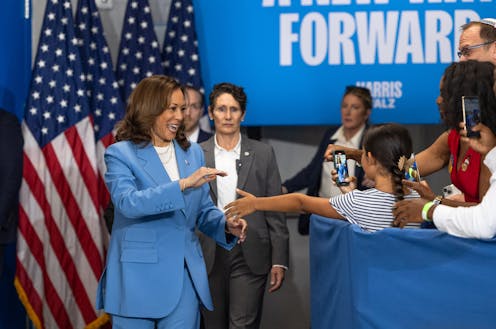Will Kamala Harris’ candidacy inspire other women to run for office? Grant Baldwin/Getty Images
Kamala Harris is at the top of a major party ticket running for president. Some people have celebrated her candidacy, hoping that it will excite voters enough to elect the first woman president.
But the glass ceiling that stymied Hillary Clinton’s presidential bid in 2016 is still sturdy at other levels of political office across the country.
My research with Diana Da In Lee, Yamil Velez and Chris Warshaw shows that in cities and counties, women remain underrepresented among local officeholders in nearly every political office.
Like many other characteristics of officeholders, such as occupation or race, the gender of elected officials influences the way they make policy. Research has shown that women, and especially working-class women, elected to state and federal government offices in countries around the world make different spending decisions. Having more women in elected offices might matter especially at the local level, where the details of many of these federal or state spending decisions actually play out.
Congress is infamous for having few women in office. But until now, researchers and the public knew very little about how women and different racial groups were represented outside the federal government.
We gathered data from city, county and school district elections covering the past three decades in any city with a population of at least 50,000 people and any county with a population of at least 75,000 in 2020. Using this data, we calculated the share of winning candidates who were women or men.
Our published research shows that women make up a smaller share of elected officials in county governments and city governments than they represent in the population.
The gap between women’s share of the population in counties and women’s share of officeholders in counties is especially large. While women make up just over half of the population in counties, they make up only a little over a quarter of legislators who serve on county councils or county commissions. Women serving as county executives, sheriffs and prosecutors are even rarer. The office of sheriff is especially dominated by men, with women serving in less than 5% of these positions.
City government offices look a little better for women’s representation. Women are not well represented in the mayor’s office – only 24% of mayors are women – and just over a third of elected city councilors are women. The relatively smaller gender gap of elected officials in city government is an improvement over counties, but it is far from gender parity.
School boards are the one exception. On the school boards we studied, women are slightly overrepresented in office relative to men. This may be a result of school boards being what political scientists like us call “stereotype congruent” offices for women, whom voters see as more competent in areas such as education and health.
People learn early in life, through a process researchers call “gendered political socialization,” to question women’s place in politics. For this reason, women are less likely to express an interest in politics or run for office, and they first show this lack of political ambition early in their childhood. Other research shows that in adulthood, gendered expectations of women to have successful careers alongside motherhood can further limit their interest in running for office. Our research shows the consequences of these ambition gaps between men and women in politics: Women remain underrepresented in nearly every local political office, except for school boards.
As Kamala Harris takes on Donald Trump in the presidential election this fall, many pundits and voters are celebrating the representation of women – and in particular, women of color – in politics. But no matter the outcome in November, the gender gap between city and county residents and their local elected officials will be large. As a result, the important policies that local governments make might not fully represent the wishes of the people.
Justin de Benedictis-Kessner has previously received grant funding for his research from the Bloomberg Center for Cities at Harvard University, the MIT Election Data + Science Lab, Time-sharing Experiments for the Social Sciences (TESS), the Massachusetts Department of Transportation, and the Boston Area Research Initiative.













